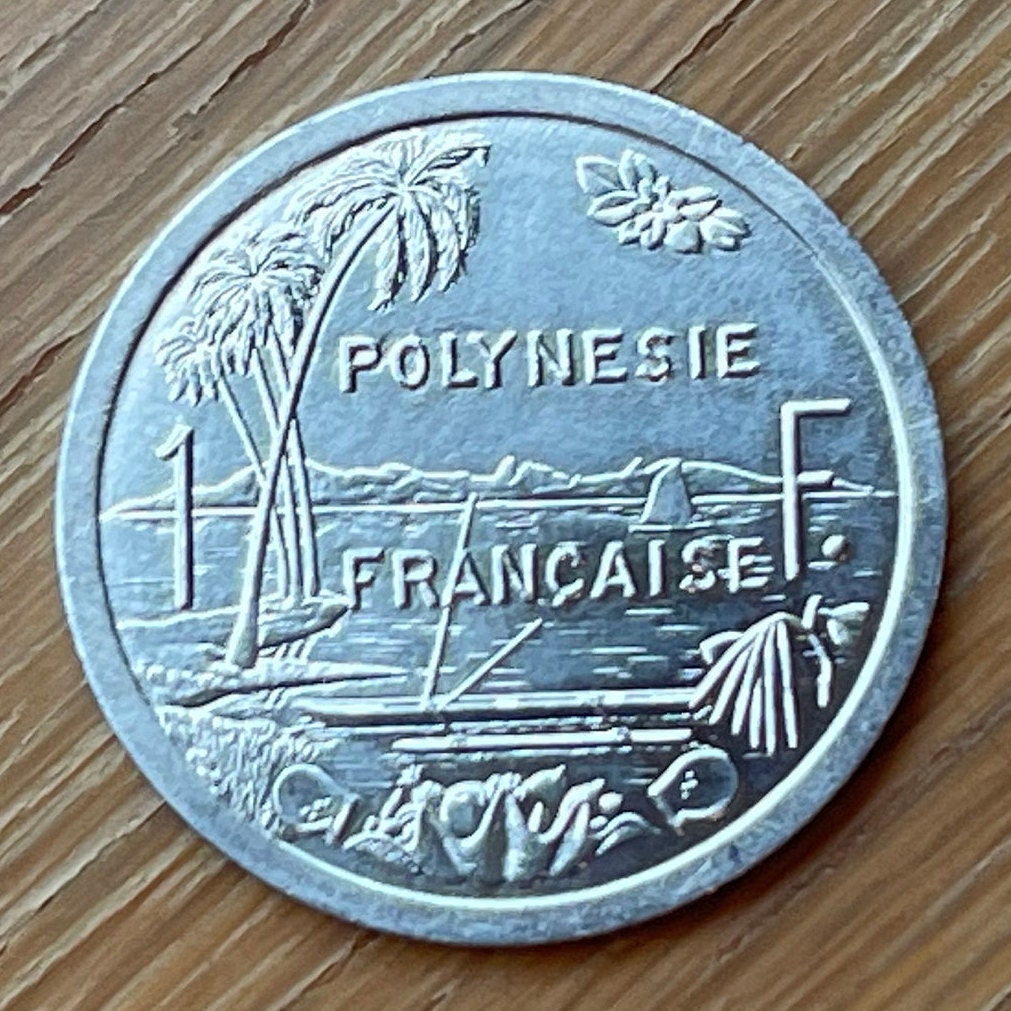elemintalshop
Tahiti Beach 1 Franc, Outrigger Canoe, Sailboat & Liberty on Throne French Polynesia Authentic Coin (South Pacific Island) (Marquesas)
Tahiti Beach 1 Franc, Outrigger Canoe, Sailboat & Liberty on Throne French Polynesia Authentic Coin (South Pacific Island) (Marquesas)
Couldn't load pickup availability
Tahiti Beach Paradise & Liberty on Throne 1 Franc French Polynesia Authentic Coin Money (South Pacific Island) (Sailing) (Marquesas) (Outrigger Canoe)
Obverse: Liberty sitting on throne, facing left holding lit torch in left hand. Assorted fruit in a cornucopia in bend of right arm.
Lettering: REPUBLIQUE FRANÇAISE
2007
Reverse
Palm trees on left, sea with sailboat in middle, mountains in distance. Boat with outrigger in foreground, plus assorted fruit in container.
Lettering: POLYNESIE
1 F.
FRANÇAISE
Features
Issuer French Polynesia
Period French overseas territory (1957-2003)
French overseas collectivity (2003-date)
Type Standard circulation coin
Years 1975-2020
Value 1 Franc
1 XPF = USD 0.0088
Currency CFP Franc (1945-date)
Composition Aluminium
Weight 1.3 g
Diameter 23 mm
Thickness 1.4 mm
Shape Round
Technique Milled
Orientation Coin alignment ↑↓
Number N# 1352
References KM# 11, Schön# 12
Wikipedia:
French Polynesia (/ˈfrɛntʃ pɒlɪˈniːʒə/ (About this soundlisten); French: Polynésie française [pɔlinezi fʁɑ̃sɛz]; Tahitian: Pōrīnetia Farāni) is an overseas collectivity of France and its sole overseas country. It comprises 118 geographically dispersed islands and atolls stretching over more than 2,000 kilometres (1,200 mi) in the South Pacific Ocean. The total land area of French Polynesia is 4,167 square kilometres (1,609 sq mi).
French Polynesia is divided into five groups of islands: the Society Islands archipelago, comprising the Windward Islands and the Leeward Islands; the Tuamotu Archipelago; the Gambier Islands; the Marquesas Islands; and the Austral Islands. Among its 118 islands and atolls, 67 are inhabited. Tahiti, which is in the Society Islands group, is the most populous island, being home to nearly 69% of the population of French Polynesia as of 2017. Papeete, located on Tahiti, is the capital of French Polynesia. Although not an integral part of its territory, Clipperton Island was administered from French Polynesia until 2007.
The legal tender of French Polynesia is the CFP franc which has a fixed exchange rate with the euro.
*******
Early settling of Tahiti
The first Tahitians arrived from Western Polynesia sometime around 1000 AD, after a long migration from South East Asia or Indonesia, via the Fijian, Samoan and Tongan Archipelagos. This hypothesis of an emigration from Southeast Asia is supported by a range of linguistic, biological and archaeological evidence. For example, the languages of Fiji and Polynesia all belong to the same Oceanic sub-group, Fijian–Polynesian, which itself forms part of the great family of the Austronesian languages.
This emigration, across several hundred kilometres of ocean, was made possible by using outrigger canoes that were up to twenty or thirty meters long and could transport families as well as domestic animals. In 1769, for instance, James Cook mentions a great traditional ship (va'a) in Tahiti that was 33 m (108 ft) long, and could be propelled by sail or paddles. In 2010, an expedition on a simple outrigger canoe with a sail retraced the route back from Tahiti to Asia.
******
Landings of the whalers
In the 1790s, whalers began landing at Tahiti during their fishing expeditions in the southern hemisphere. The arrival of these whalers, who were subsequently joined by merchants coming from the penal colonies in Australia, marked the first major overturning of traditional Tahitian society. The crews introduced alcohol, arms and infectious diseases to the island, and encouraged prostitution, which brought with it venereal disease. These commercial interactions with westerners had catastrophic consequences for the Tahitian population, which shrank rapidly, ravaged by diseases and other cultural factors. During the first decade of the 19th century, the Tahitian population dropped from 16,000 to 8,000–9,000; the French census in 1854 counted a population just under 6,000.
********
The French painter Paul Gauguin lived on Tahiti in the 1890s and painted many Tahitian subjects. Papeari has a small Gauguin museum.
*********
Between 1966 and 1996 the French Government conducted 193 nuclear bomb tests above and below the atolls of Moruroa and Fangataufa. The last test was conducted on 27 January 1996.
***********
Tahitians are French citizens with complete civil and political rights. French is the official language but Tahitian and French are both in use. However, there was a time during the 1960s and 1970s when children were forbidden to speak Tahitian in schools. Tahitian is now taught in schools; it is sometimes even a requirement for employment.
During a press conference on 26 June 2006 during the second France-Oceania Summit, French President Jacques Chirac said he did not think the majority of Tahitians wanted independence. He would keep an open door to a possible referendum in the future.
Share










5 stars review from William









